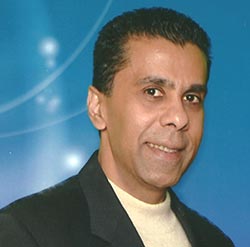MPC
NDSU, UND Awarded Patent for Unmanned Aircraft Systems Technology
Posted: Jul 3, 2018
 NDSU and the University of North Dakota have received a patent for technology that integrates energy-storing capacitors into the body or other large components of manned and unmanned aircraft systems, known as UAS.
NDSU and the University of North Dakota have received a patent for technology that integrates energy-storing capacitors into the body or other large components of manned and unmanned aircraft systems, known as UAS.
"This capacitor technology, which will supplement batteries, will allow for greater range, longer endurance and enhanced reliability of UAS," according to NDSU researcher Raj Bridgelall. Although similar to a battery, a capacitor stores an electric charge while a battery generates an electric charge from a chemical reaction.
Bridgelall leads the Center for Surface Mobility Applications and Real-Time Simulation environments (SMARTSe) at NDSU's Upper Great Plains Transportation Institute. He developed the technology with Michael Corcoran, UAS course manager with the John D. Odegard School of Aerospace Sciences at UND.
"This development allows UAS to fly further on a single charge without increasing weight," Bridgelall notes. This will enable autonomous UAS operations beyond the visual line of sight." Such operations are normally prohibited by the Federal Aviation Administration, but an exception has been granted in North Dakota to test them.
"Consequently, this advance is particularly timely," Bridgelall said. Also, integrating capacitors into the structure of UAS frees up space for instrumentation such as cameras and sensors.
Batteries are often one of the heaviest components of UAS. Providing an alternative source of power will cut weight and provide a redundant power source for on-board avionics that provide precision navigation and flight control. Currently, the lack of redundant power systems poses some safety concerns, which is why the FAA limits the use of UAS beyond the line of sight.
Bridgelall notes the technology also may have applications in land-based and marine-based remotely operated vehicles. "Those vehicles face many of the same constraints on size, range and battery life as UAS," he said.
Bridgelall and Corcoran also have applied for a patent on technology that integrates UAS antennas into the airframe and other large components. In addition to reducing aircraft weight, the concept also will cut the drag associated with traditional antennas. The antenna system will enhance the ability to collect and transmit data from stationary antennas or electronics such as Radio Frequency Identification (RFID) tags.
Corcoran has extensive experience at UND and in the military with UAS. Bridgelall is an expert on RFID and other electronic data collection and communication technology.
As a student-focused, land grant, research university, we serve our citizens.

